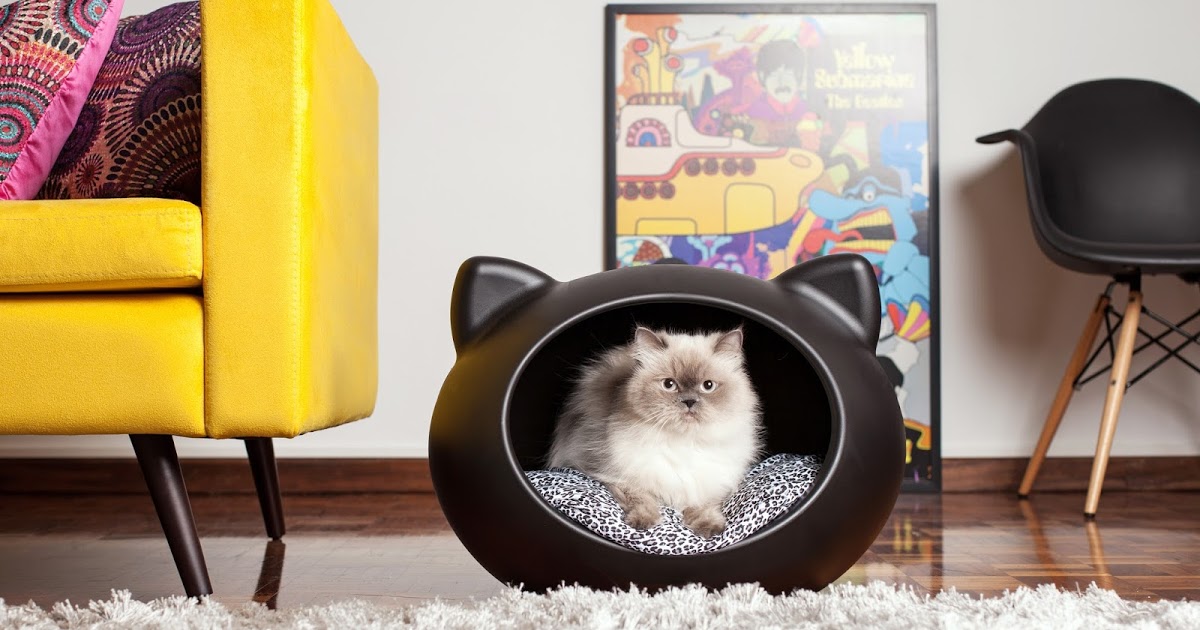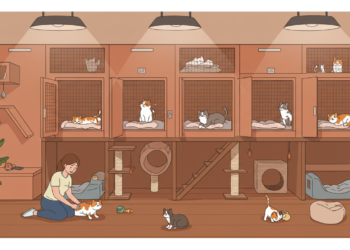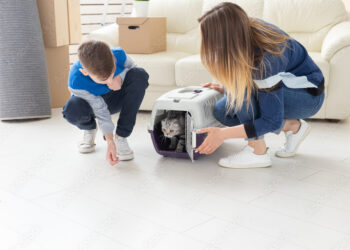The cat is an animal that clings to the routine to feel safe and avoid anything that endangers its health and well-being. Unlike other pets, the cat’s routine is generally quite marked, since it is common to observe that it follows the same schedules of food, sleep, play, hygiene or socialization.
For this reason, sudden changes in the environment often generate a lot of stress in the cat, in addition to other negative emotions, such as fear, anxiety, and insecurity. For the feline, the move is a very important change.
Therefore, if you are considering moving with a cat, it will be essential to understand that they will need their own time to adjust to the new home. Ideally, this transition should be done gradually, never suddenly and sharply. In this way, it will be possible to promote the adaptation of your cat and to put him at ease and safety in his new home.
You May Like: Boy Cat Names; Find the Perfect Male Kitten Name
Want to know How to move with a cat? So we invite you to continue reading this article to discover some very useful tips and recommendations that will help you succeed in this process. Often we will see a cat meowing, a stressed cat, or a cat in depression after the move. All of this is “normal”, a cat’s adaptation to its new home is often difficult and slow. However, if you are caring and attentive to their behavior, your cat will quickly turn back into a happy and healthy feline.
Before the cat moves
As we told you in the introduction, cats are routine-loving animals, so sudden changes can easily cause stress and anxiety. Understanding this point is essential because before we start with our tips for moving with an adult cat, we want to remind you that as a responsible guardian, you must respect the time to adapt to their new home and do everything possible. to encourage change without it becoming a bad experience, which could quickly lead to trauma.
No animal, regardless of age, sex or breed, is able to instantly adapt to a new reality or to a new environment (indeed like us humans). Adaptation in itself is a process and each individual needs their own time to overcome it in a positive way.
Moving is a complex experience for cats at all stages of their lives. However, kittens or young cats tend to be more adaptable and flexible than adult cats. That’s not to say that adult or older cats can’t experience a good move, but they will need more patience and dedication from their guardians.
8 practical tips on how to move with a cat
Now that you know how the cat can experience the move, you should know 8 practical tips to make his adaptation to his new home as positive as possible:
Turn the move with your cat into something positive
The first thing you need to do to get your cat to take the movement as something positive and to go through it with ease is to take it this way yourself. If the thought or process of moving is causing you nervousness, anxiety, or stress, your body language will express these negative feelings and it will not go unnoticed by your cat’s powerful senses.
Suggested Read: Best Cat Breeds for Beginners: a Comprehensive Guide to Choose
When you notice your mood swings, your cat is likely to be suspicious and will also take in the events around him in a negative way. So our first tip for moving with an adult cat is to make the move, right from the start, in a positive way, keeping calm and planning each step so that you don’t have unforeseen events or accidents during the transition to the new home. By perceiving your calm and security, your kitten will also feel calmer and more secure to live this new experience.
Pack your things and make your boxes little by little
Lack of planning and last-minute haste are two factors that make moving a stressful experience not only for you but for your cat as well. If you leave to pack your bags in a day or two in a hurry, you are likely to feel stressed and exhausted both physically and mentally.
In addition, this last-minute run means exposing your cat not only to a sudden change in his surroundings but also to the stress and mistrust of observing your unusual “wiggle”, the accumulation of boxes around him and her. the “disappearance” of the elements in its environment. If you plan your move step by step and pack your things little by little, one box at a time, you smooth out the changes in your cat’s environment and
Offer shelter to your cat during the “comings and goings” of the move
The time to unload the boxes and take them to the new house is a “back and forth” that is chaotic for your cat. Traveling from here to there, stacking boxes, entering strangers into their territory, emptying the house. All of this can generate a lot of stress for your cat, for this reason, the best is to prepare a safe and calm refuge for her in a room, where your kitten can stay away from the “comings and goings” of the move and remain calm while enjoying her bed or her toys.
You can also put some relaxing music in the surroundings or just leave the television on so that outside noises don’t disturb your cat’s peace. Another helpful tip is to leave a cardboard box for your cat to use in this secure room, with a few toys, some cat treats, and a blanket inside. This way your cat will also have a “cocoon” in case he feels a strange movement or a loud noise coming from the movement.
Read Also: Hairballs in Cats: Causes, Symptoms, and Remedies
Collect your cat’s things at the last minute
While we recommend that you pack your belongings and household items little by little, it is essential to leave your cat’s belongings at the last minute, when you have them secured in their crate and are ready to go. go to the new house.
This way, we prevent the cat from feeling nervous or anxious when it identifies a sudden change in its surroundings. The carrier is a key part of a domestic cat’s routine because it allows you to transport the cat safely, whether you are taking it to the vet, moving it, or traveling with your cat. It is therefore essential that your cat gets used to staying calm in his crate and that he stays calm when traveling by car. On Animal Planet, to travel by car with your cat and properly accustom him to its transport.
Always take your cat with you
Moving with your cat also means transporting him from point A to point B. After making sure that he is calm in his crate and that he picks up all her things, it’s time to go back to her new home. Throughout the journey, it is essential that your cat travels with you, with the necessary comfort and safety.
Your cat shouldn’t come near boxes or feel stuck in a moving truck. Always carry your cat with you, conveying your tranquility and affection, and making sure they feel comfortable and secure throughout the journey.
Release it when everything is ready
when you get to the new house, you will need to repeat the “safe house” strategy you adopted for making the move, but in the other direction. Make sure to prepare a clean and safe room for your cat, where he will find his bed, his toys and accessories, his waterer and his bowl, as well as the other items that made up his safe shelter before leaving his old home.
You can also leave the same cardboard box, with its toys, treats, and blanket inside. This way you sweeten the feeling of arriving in a totally strange place, presenting it in a way similar to your family and the family environment of the old house. As you put away the boxes and complete the process of arriving at the new home, let your cat feel safe in their shelter. When the back and forth of the move is over and peace reigns in your new home, you can let your cat go, after having verified that the environment is completely safe and positive for him.
Reading Suggestion: Powerful tips to Remove the Smell of Cat Urine?
Give your cat the freedom and time
Once again, you remember the importance of giving your cat the time and freedom to explore her new home, according to his own instinct. In addition to ensuring the safety and hygiene of the new home, it will be essential to provide an enriched environment that stimulates their natural curiosity and allows them not only to be entertained but also to develop their cognitive, emotional, and social skills.
Spend time with your cat in their new home
While all of the tips above are very helpful when moving with an adult cat, the key to making your cat feel comfortable, safe, and well. welcomed into his new home is the affection and dedication of his guardian. So never forget to take the time to play with your cat in the new home, prepare a delicious homemade meal for him, or just enjoy his company while he sleeps next to you on the sofa. Love is the most powerful ingredient in turning a property into a real home.
How long to keep a cat indoors after moving?
Wondering how long it takes for a cat to adjust to its new home? The weather is variable and will depend on his own personality and the environment offered by his tutors. You will need to be patient and respect that your cat is taking their time to feel safe and start wanting to explore their new home. Remember that forcing a cat to do something against their own will is totally counterproductive for their adaptation, health, and education.

It is certainly natural for a cat to be more shy, confused and even a little scared when it first arrives in an unfamiliar environment and meets all of the new stimuli of that environment. For this reason, he may prefer to be in hiding for the first few days or be more reserved about his behavior in the old house.
However, in addition to respecting it, there are several ways you can help your cat. First, by providing a positive, comfortable and peaceful environment where your cat feels safe to express himself freely and explore his new surroundings. A balanced diet and basic health care will also be essential to ensure the well-being and optimal development of your cat before, during and after a move.
In general, cats can take a few weeks to several months to adjust to a new home.
For more tips, follow us on social media channels like Facebook, Twitter and Pinterest.








